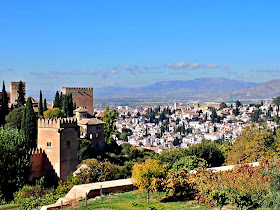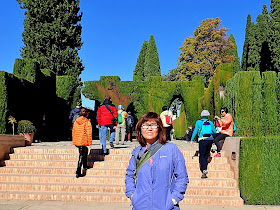 |
| Good morning and hello Alhambra, we were making our way through streets and steep alleys looking for you. |
 |
| Somewhere along Gran Vía de Colón Street we made enquiry as how to get around in Granada. First we decided to visit a view point at Plaza St. Nicolas before spending the whole day at Alhambra. |
 |
| We took an Alhambra mini bus numbered C32 to Plaza St. Nicolas, known for its viewing platform. |
 |
| Finally we reached Alhambra at the main entrance. Jo have has purchased the tickets online prior to our visit. It was the Alhambra General Daytime ticket amounting 14.85€ per head. |
 |
| The view from Generalife towards Alhambra and its community at the lower ground. |
 |
| Covering the gardens and trying not to miss out any of the interesting elements of Generalife. |
 |
| The Garden of the Irrigation is one of the main features connecting the 2 group of buildings. |
 |
| Nasrid Palace and Alcazaba as seen from Palacio del Generalife, Alhambra |
 |
| Time to re-fuel and rest the leg before proceeding to the next spot. Obviously we were prepared as far as food and drink are concerned in the park. |
 |
| A chance to observe how these big hedges of plant were being manicured. |
 |
| A ruin where we passed by while moving towards the Palace of Charles V, a potential site to be improved and make it exciting for tourists. |
 |
| I thought it was a bull fighting ring the moment I came into the building as the has an inner circular patio. No it was no a bull fighting ring but a two storey palace. |
 |
| Another image captured of the circular patio. The palace that was not completed initially and remained roofless until the late twentieth century. |
 |
| When the Christians took the city, they carried out many works to repair the Alcazaba. At certain part of the history it was used as a State prison, even during the French occupation. |
 |
| Like the Alhambra, the Alcazaba was abandoned and not cared for a long time and it was not until the late 19th century and beginning of the 20th century that the restoration began. |
 |
| Our last place to visit with a scheduled time to enter the Palace of Nazri. We had to queued for the entrance and security was observed when entering. |
 |
| The courtyards, continuous allusions to the garden, with elements of Persian and Muslim inspiration. |
 |
| A peep into the court yard as we were flowing through with the stream of tourists in the palaces. |
 |
| That's was it we finally visited Alhambra and had a good knowledge of the Muslim influence in this part of Europe. |
















No comments:
Post a Comment